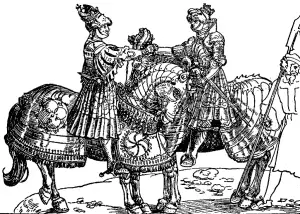 On Tuesday 16th August 1513, the Battle of the Spurs, if it can be called a battle, took place at Guinegate (Enguinegatte) in France.
On Tuesday 16th August 1513, the Battle of the Spurs, if it can be called a battle, took place at Guinegate (Enguinegatte) in France.
England was allied with the Empire at this point, so the battle was to be between the Holy League (the joint forces of Henry VIII and Emperor Maximilian I) and Francis I of France. Chronicler Edward Hall describes the scene that day:
“Then the horsmen set forward, and the archers alighted and wore set in order by an hedge all a long a village side culled Bomye: the Frenchmen came on with xxxiii. standardes displayed, and the archers shotte a pace and galled their horses, and the English speres set on freshly, cryeng sainct George, & fought valiantly with the Frenchmen and threw downe their standards, the dust was great and the crye more, but sodainly the Frenchmen shocked to their standards and fledde, and threw away there speres, swerdes, and mases and cut of the bardes of their horses to ronne the lighter, when the hinder parte saw the former fly, they fled also, but the soner for one cause which was this. As y English horsmen mounted vpp the hill, the stradiates were comyng downe wardes on the one syde of the hill before the French hoste, which sodainly saw the banners of the English horsmen, and the kynges battayle folowyng vpwarde, wenyng to them that all had been horsmen, then they cast them self about and fledde, the Frenchmen so fast in array that the stradiates could haue no entre, and so they ran still by thedes of y ranges of the French army: and when they behynde saw the fall of their standardes and their stradiates in whome they had greate confidence retorne, they that were farthest of fledde firste, then vp pranced the Burgonyons and folowed the chace: this battaile was of horsmen to horsmen but not in egal nomber, for the Frenchmen were. x. to one, which had not byn sene before tyme, that Thenglishe horsemen gatt the victory of the men of armes of Fraunce. The Frenchmen call this battaile the iourneyof Spurres because they rune away so fast on horsbacke.”
So, it seems more of a brief skirmish rather than a battle. Historian J.J. Scarisbrick writes of the encounter: “There was no pitched battle – only a hurtling gallop across the fields at Guingates.” However, the fact that six standards were left behind and a duke, marquis and the vice-admiral of France were captured “was enough to give the skirmish the aura of an heroic victory – the so-called Battle of the Spurs – and to allow Henry to describe it in grandiose terms.”
You can read more, including Henry VIII’s account of the battle, in my article from 2010 – click here.
Picture: Contemporary woodcut of the meeting of Henry VIII and Maximilian at the siege of Thérouanne.